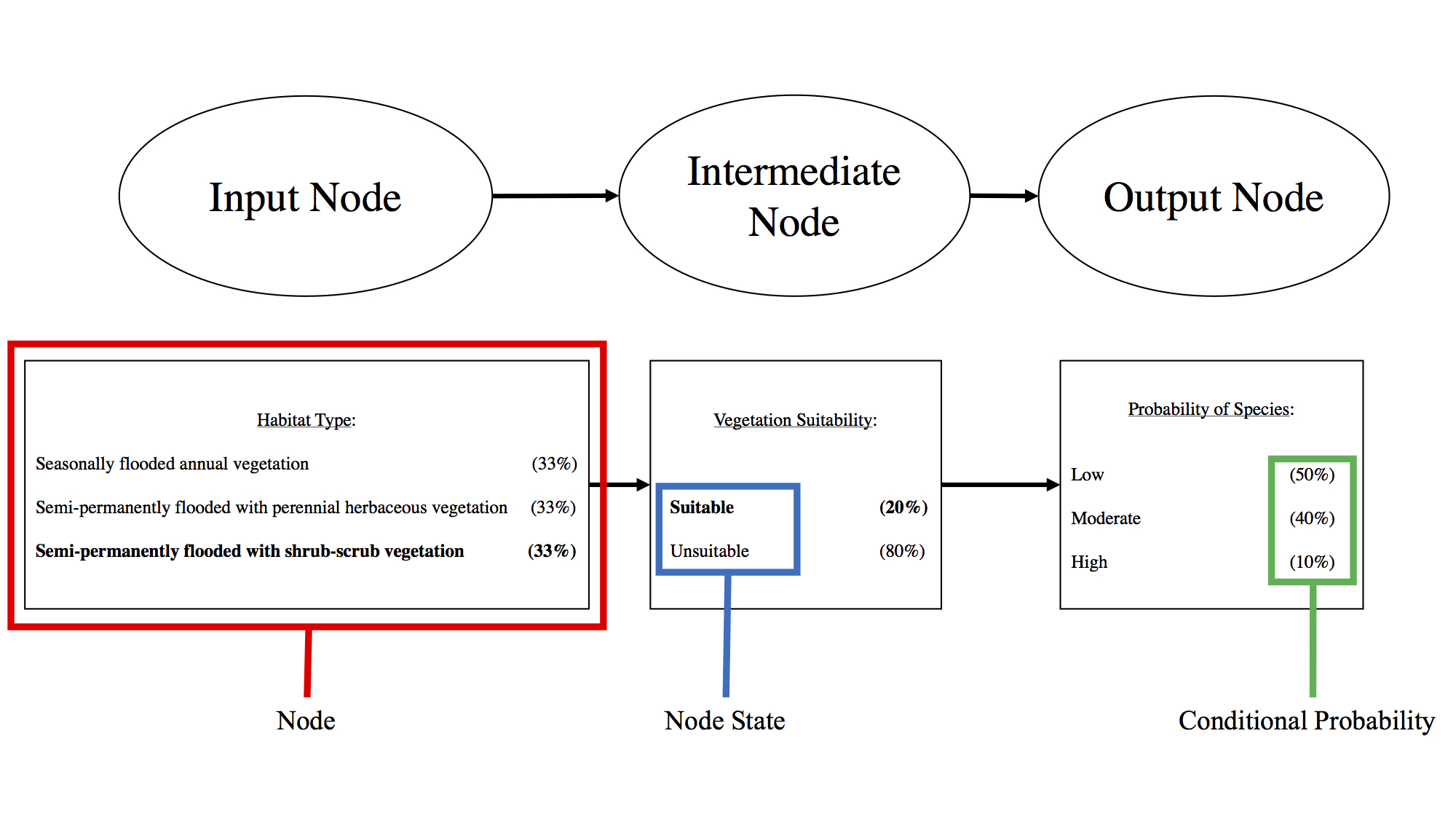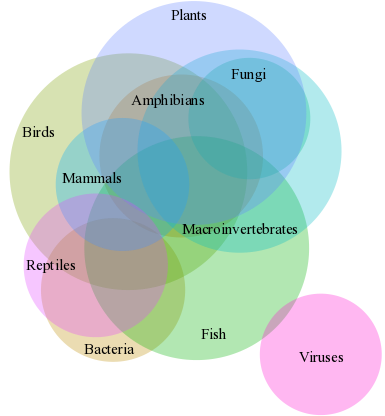What is a BN? A Bayesian network (BN) model exhaustively explores potential ecological variables defining a species’ niche as well as producing metrics of uncertainty surrounding estimates of habitat requirements. It is a graphically-based probabilistic model (i.e., uses influence diagrams), that systematically examines all possible values of variables that may influence the presence or distribution of individuals (see Figure 1 below). BNs consist of input, intermediate and output nodes that are linked together via conditional probability tables (CPTs) according to hypothesized causal relationships. In the ecological literature, BNs go beyond species-habitat correlations because they explicitly consider discrete processes that influence presence across space (i.e., access to and selection of habitat). Unlike most correlative species distribution modelling methods, Bayesian belief networks (BBNs) use multiple data sources, including soliciting expert knowledge, to explicitly test as many ecological variables as possible that could contribute to species distributions (i.e., multiple hypothesis testing).
Why is expert knowledge needed in BBNs? As expert knowledge often includes details not available in empirically derived research, the inclusion of expert knowledge in BBNs has been effective for distinguishing between regularly confounded drivers of occupancy when research is simply lacking, or when there is an abundance of zero-counts in monitoring studies. Expert knowledge is especially useful for improving seasonal models where the influence of seasonal dynamics on species presence may not be well understood. By quantitatively testing an exhaustive set of ecological variables from all available sources (expert knowledge, gray literature and primary literature), the BBN approach enables the calculation of uncertainty surrounding the response to each environmental variable (node) contributing to species distributions and/or abundances by using either uncertainty analyses or sensitivity analyses. Uncertainty typically arises when the measurement of a parameter is too coarse, meaning that small changes in that parameter result in large changes at the output node. Thus, a BBN approach can improve seasonal species distribution models by distinguishing the most important habitat criteria as well as identifying and calculating uncertainty for parameters that we don’t know enough about. With the help of taxonomic experts, we can improve the identification of the most important environmental conditions for taxa at the local-regional scale with relevance to decision-support for provincial/state governments. Furthermore, models improved with expert knowledge promote the identification of landscape variables that contribute the greatest uncertainty to the presence of individuals (i.e., portions of species-habitat relationships that need further research to more accurately predict species presence).
Want to keep reading? Here are my favourite ecological studies that used BBNs:
Chee et al. 2016. Modelling spatial and temporal changes with GIS and Spatial and Dynamic Bayesian Networks. Environmental Modelling and Software. 82: 108-120.
Douglas and Newton. 2014. Evaluation of Bayesian networks for modelling habitat suitability and management of a protected area. Journal for Nature Conservation. 22(3): 235-246.
Drew and Collazo 2014. Bayesian networks as a framework to step-down and support Strategic Habitat Conservation of data-poor species: A case study with King Rail (Rallus elegans) in Eastern North Carolina and Southeastern Virginia. Prepared for the United States Fish and Wildlife Service Raleigh Field Office.
Ethier and Nudds. 2017. Complexity of factors affecting bobolink population dynamics communicated with directed acyclic graphs. Wildlife Society Bulletin. 41(1): 4-16.
Marcot 2006. Characterizing Species at Risk 1: Modelling Rare Species Under the Northwest Forest Plan. Ecology and Society. 11(2): 10.
Gray Bats (Myotis grisescens)
Click here to learn about my ongoing project with the USFWS using BBNs to improve our understanding of population dynamics in the the federally endangered migratory gray bat (Myotis grisescens).
Wetland-dependent Taxa
Click here to learn more about my ongoing project with the USGS Coop Unit at the University of Missouri and the Missouri Department of Conservation building species distribution models for wetland-dependent umbrella taxa.
(Figure 3 from MacPherson et al. 2018 - Biological Conservation)


